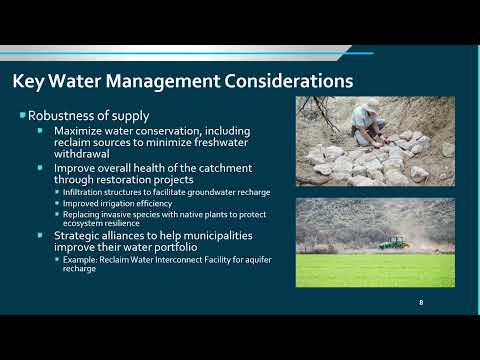
Collaborators
Tags
ConstructionEnergy ConservationWater ConservationFour reasons to collaborate on environmental sustainability: UPM 2022 panel discussion recap
Key takeaways about semiconductor facilities’ environmental footprint in relation to water consumption, energy usage, and site selection considerations.
Share this insight
These points are distilled from the insights delivered by Dane Louvier, Senior Manager – Taylor Fab Design, Construction, and Site Planning at Samsung Austin Semiconductor; Kelly Osborne, Senior Staff Engineer at Intel Corporation; and Josh Best, Vice President of Innovation at FTD Solutions. Watch the recording in the conference library.
1. Collaboration between experts in different focus areas can provide optimal solutions for increasing resource consumption Several chip manufacturing developments necessitate more energy, water, and chemical consumption. Fab size is increasing to meet chip demand and to incorporate new process complexity. As transistors get smaller and 3D chip structures are adopted, the number of process steps increases, and new materials are added into the manufacturing process.
These developments have environmental implications across multiple fab areas. Examples of increased resource consumption include:
- More ultrapure water (UPW) for wafer rinsing as purity requirements increase
- More chemical and UPW usage with each process step, and more energy for treating chemical waste or wastewater
- More energy for producing greater quantities and higher qualities of clean air
- More water and energy for gas abatement, as the manufacturing process produced more toxic gases, and air permits tighten.
Collaboration between engineers in different expertise areas provides a pathway to find optimal approaches for competing sustainability goals (such targets related to water, energy, gas emissions, and waste). An example of such collaboration is the new International Roadmap for Devices and Systems (IRDS) focus team for water and energy. The initiative will define challenges and drivers, gather key performance indicators, and identify critical technology gaps.
2. The key to water sustainability is collaboration between the fab and facility partners The top priority of fab engineers is to ensure high wafer yield, and therefore their main concern is the water quality impacting the wafer. This takes priority over efforts to reduce tool water usage or use recycled water in the manufacturing process.
To reduce tool water usage, facilities engineers can engage with the fab teams. Implementation of the right data collection strategies can help to understand the right water flows for maintenance or idle purges to achieve optimal contamination control.
To encourage higher rates of recycling water back to the UPW makeup stage, new recycling methods or technologies should be paired with data and evidence that the returning water quality will not impact yield. Pilot studies are more likely to have a convincing impact than bench scale studies.
3. Collaboration between facilities and municipalities can ensure a robust water supply With accelerating water consumption and increasingly diverse chemistries, facilities must closely consider their relationships with municipalities and the publicly owned treatment works (POTW):
- Huge loads of wastewater put stress on the POTW treatment capacity.
- There is higher danger of falling into compliance issues if wastewater is not treated onsite, and fabs must consider the impact of specialty chemicals interacting with other water sources in the POTW.
- Relying on the POTW effluent for larger quantities of reclaim water for use in the fab may affect municipal water supply.
Some solutions can be observed in the industry through collaboration with municipalities. For example, to avoid sending problematic wastewater streams to the POTW when there is a spike in contamination, fabs can build emergency water storage capabilities to hold highly contaminated water until a solution is found. Additionally, fabs can work with municipalities to improve their water portfolio, such as treating water which can replenish city aquifers.
4. Collaborative efforts to reduce utility consumption can open up new possibilities for fab locations Site selection is extremely complicated with many factors at play, with different choices made based on the product type and technology node. For example, it is important to consider:
- Supply chain considerations (availability of local labor; proximity to existing suppliers; competition for resources with other industries)
- Local topography and climate (including risk of natural disaster)
- Regional regulations (wastewater discharge regulations and permitting; air permits; hazardous materials regulations)
- Local government incentives and capital investment costs.
- Space and utility supply for current project and future expansion (including natural gas, electricity, and water supply)
Utility supply significantly constrains site selection. Collaboration to reduce this constraint can open possibilities for geographical locations. For example, if the supply chain can collaborate to develop methods for achieving close to 100% recycling rates, that reduces the constraint of local water supply infrastructure,
Share this insight
Related insights
5 trends from the UPM 2023 Environmental Sustainability Panel

Orla McCoy
Global Water Intelligence
Intel Water Usage: Chart

Orla McCoy
Global Water Intelligence
Digital transformation: opportunities and challenges for the semiconductor industry

Georgia Bottomley
Global Water Intelligence
Related resources

Keynote panel: Environmental footprint
Environmental Sustainability - Opening Panel 2023
Sustainable Water Usage in Semiconductor Manufacturing
